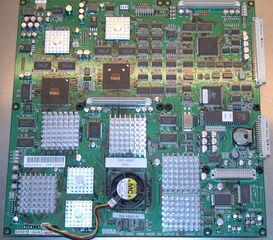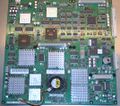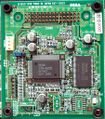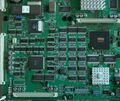Difference between revisions of "Sega Hikaru"
From Sega Retro
m (Text replacement - "maker=Sega" to "maker=Sega Enterprises, Ltd.") |
|||
| (6 intermediate revisions by 4 users not shown) | |||
| Line 4: | Line 4: | ||
| imgwidth=320 | | imgwidth=320 | ||
| name= | | name= | ||
| − | | maker=[[Sega]] | + | | maker=[[Sega Enterprises, Ltd.]] |
| distributor= | | distributor= | ||
| variants= | | variants= | ||
| Line 15: | Line 15: | ||
}} | }} | ||
}} | }} | ||
| − | The '''Sega Hikaru''' is a successor of the [[Sega NAOMI]] and [[Sega Model 3]] [[arcade]] systems that was developed in 1998 and debuted in 1999. The Hikaru was used for a handful of deluxe dedicated-cabinet games, beginning with 1999's ''[[Brave Fire Fighters]]'', in which the flame and water effects were largely a showpiece for the hardware. | + | The '''Sega Hikaru''' is a successor of the [[Sega NAOMI]] and [[Sega Model 3]] [[arcade]] systems that was developed in 1998, most likely by Hard Ware R&D Team 3{{intref|Brave Firefighters#Production_credits}} and debuted in 1999. The Hikaru was used for a handful of deluxe dedicated-cabinet games, beginning with 1999's ''[[Brave Fire Fighters]]'', in which the flame and water effects were largely a showpiece for the hardware. |
It was significantly more powerful and expensive than the NAOMI. The Hikaru featured a custom Sega GPU with advanced graphical capabilities, additional CPU and sound processors, various custom processors, increased memory, and faster bandwidth. It was the first game platform capable of effective hardware [http://www.giantbomb.com/phong-shading/3015-7940/ Phong shading], the most intensive form of shading at the time, and was capable of the most complex lighting and particle effects of its time. | It was significantly more powerful and expensive than the NAOMI. The Hikaru featured a custom Sega GPU with advanced graphical capabilities, additional CPU and sound processors, various custom processors, increased memory, and faster bandwidth. It was the first game platform capable of effective hardware [http://www.giantbomb.com/phong-shading/3015-7940/ Phong shading], the most intensive form of shading at the time, and was capable of the most complex lighting and particle effects of its time. | ||
| − | It was the most powerful game system of its time (''[[Planet Harriers]]'' | + | It was the most powerful game system of its time (''[[Planet Harriers]]'', for example, was regarded as having the best video game graphics at the time), but it was very expensive and difficult to program. Since it was comparatively expensive to produce, [[Sega]] soon abandoned the Hikaru in favor of continued NAOMI development. It was succeeded by the more affordable [[Sega NAOMI 2|NAOMI 2]].{{magref|nextgeneration|76|37}} |
==Technical specifications== | ==Technical specifications== | ||
| Line 98: | Line 98: | ||
* GPU capabilities: 2 [[wikipedia:Bitmap|bitmap]] layers, calendar, 16,384 vertices per mesh,{{ref|[https://github.com/stefanoteso/valkyrie/blob/master/src/mach/hikaru/hikaru-gpu-private.h Sega Hikaru GPU Private (Valkyrie)]}} hidden surface removal, deferred rendering | * GPU capabilities: 2 [[wikipedia:Bitmap|bitmap]] layers, calendar, 16,384 vertices per mesh,{{ref|[https://github.com/stefanoteso/valkyrie/blob/master/src/mach/hikaru/hikaru-gpu-private.h Sega Hikaru GPU Private (Valkyrie)]}} hidden surface removal, deferred rendering | ||
:* [[wikipedia:Framebuffer|Framebuffer]]: 2048×2048 sheet (can be partitioned into framebuffer, tile data, and/or 1‑2 bitmap layers), handled by 2 GPU 1A Image Generator rasterizers/renderers (double‑buffering), accessible by DMA controller | :* [[wikipedia:Framebuffer|Framebuffer]]: 2048×2048 sheet (can be partitioned into framebuffer, tile data, and/or 1‑2 bitmap layers), handled by 2 GPU 1A Image Generator rasterizers/renderers (double‑buffering), accessible by DMA controller | ||
| − | :* Effects: [[wikipedia:Stencil buffer|Stencil]], shadows, motion blur, particle effects, fire effects, [[wikipedia:Fluid simulation|water effects]],{{ref| | + | :* Effects: [[wikipedia:Stencil buffer|Stencil]], shadows, motion blur, particle effects, fire effects, [[wikipedia:Fluid simulation|water effects]],{{ref|http://archive.is/nyrP3|http://www.goodcowfilms.com/farm/games/news-archive/Sega%20Confirms%20Hikaru%20DOES%20Exist....htm}} fog, alpha blending, anti‑aliasing, specular effects,{{fileref|NAOMI 1998 Press Release JP.pdf}} |
:* Features: [[wikipedia:Tiled rendering|Tiled rendering]], [[wikipedia:Deferred shading|deferred rendering]], [[wikipedia:Back-face culling|back‑face culling]], [[wikipedia:Hidden surface determination|hidden surface removal]] | :* Features: [[wikipedia:Tiled rendering|Tiled rendering]], [[wikipedia:Deferred shading|deferred rendering]], [[wikipedia:Back-face culling|back‑face culling]], [[wikipedia:Hidden surface determination|hidden surface removal]] | ||
:* [[wikipedia:Phong shading|Phong shading]]: Per‑[[pixel]] lighting/shading computation processed by rasterization pipeline,{{ref|1=[https://books.google.co.uk/books?id=-4ngT05gmAQC&pg=PA871 ''Computer Graphics: Principles and Practice'' (page 871)]}} deferred rendering can prevent shading of overdrawn pixels to maximize rendering bandwidth,{{ref|1=[https://books.google.co.uk/books?id=-4ngT05gmAQC&pg=PA900 ''Computer Graphics: Principles and Practice'' (page 900)]}} all compute units could be used as shader units to maximize Phong shading performance | :* [[wikipedia:Phong shading|Phong shading]]: Per‑[[pixel]] lighting/shading computation processed by rasterization pipeline,{{ref|1=[https://books.google.co.uk/books?id=-4ngT05gmAQC&pg=PA871 ''Computer Graphics: Principles and Practice'' (page 871)]}} deferred rendering can prevent shading of overdrawn pixels to maximize rendering bandwidth,{{ref|1=[https://books.google.co.uk/books?id=-4ngT05gmAQC&pg=PA900 ''Computer Graphics: Principles and Practice'' (page 900)]}} all compute units could be used as shader units to maximize Phong shading performance | ||
* Texture capabilities: 1×1 to 2048×2048 texture sizes, [[wikipedia:Mipmap|mipmapping]], mipmap trees, texture panning, multi‑texturing, [[wikipedia:Bump mapping|bump mapping]], [[wikipedia:Normal mapping|normal mapping]], texture filtering, bilinear filtering, trilinear filtering, [[wikipedia:Reflection mapping|environment mapping]]{{fileref|NAOMI 1998 Press Release JP.pdf}} | * Texture capabilities: 1×1 to 2048×2048 texture sizes, [[wikipedia:Mipmap|mipmapping]], mipmap trees, texture panning, multi‑texturing, [[wikipedia:Bump mapping|bump mapping]], [[wikipedia:Normal mapping|normal mapping]], texture filtering, bilinear filtering, trilinear filtering, [[wikipedia:Reflection mapping|environment mapping]]{{fileref|NAOMI 1998 Press Release JP.pdf}} | ||
:* Texture banks: 2 texture banks (stored as 2× 2048×1024 sheets), stores textures from MaskROM (with 16‑byte metadata per texture in Command RAM) | :* Texture banks: 2 texture banks (stored as 2× 2048×1024 sheets), stores textures from MaskROM (with 16‑byte metadata per texture in Command RAM) | ||
| − | * Floating-point performance: 15 | + | * Floating-point performance: 15 GFLOPS (estimate){{ref|Phong shading: 2 million polygons/sec, 4 light sources per polygon, 7,898–15,796 floating-point operations per 100-pixel polygon.|group=n}} |
* Rendering [[fillrate]]: | * Rendering [[fillrate]]: | ||
:* Opaque polygons: 8 [[Pixel|GPixels/s]]{{ref|32 pixels per cycle,{{intref|Sega NAOMI}} 250 MHz|group=n}} | :* Opaque polygons: 8 [[Pixel|GPixels/s]]{{ref|32 pixels per cycle,{{intref|Sega NAOMI}} 250 MHz|group=n}} | ||
| Line 182: | Line 182: | ||
:* Boot ROM: 800 MB/s{{ref|64‑bit, 100 MHz{{fileref|CY2292 datasheet.pdf}}|group=n}} | :* Boot ROM: 800 MB/s{{ref|64‑bit, 100 MHz{{fileref|CY2292 datasheet.pdf}}|group=n}} | ||
:* ROM Board PLD: 1.45 GB/s{{ref|2× 32‑bit, 180/182 MHz{{fileref|PLSI2032 datasheet.pdf}}{{fileref|M4A3 datasheet.pdf}}{{fileref|MACH111 datasheet.pdf}}|group=n}} | :* ROM Board PLD: 1.45 GB/s{{ref|2× 32‑bit, 180/182 MHz{{fileref|PLSI2032 datasheet.pdf}}{{fileref|M4A3 datasheet.pdf}}{{fileref|MACH111 datasheet.pdf}}|group=n}} | ||
| − | :* ROM Board Connectors: 1.5 GB/s{{ref|2x 32‑bit, 182 MHz{{ref|https://web.archive.org/web/20160228172702/members.iinet.net.au/~lantra9jp1/gurudumps/wip/hikaru1.jpg}}{{ref|[https://github.com/stefanoteso/valkyrie/blob/master/src/mach/hikaru/hikaru-gpu.c Sega Hikaru GPU (Valkyrie)]}}|group=n}} | + | :* ROM Board Connectors: 1.5 GB/s{{ref|2x 32‑bit, 182 MHz{{ref|https://web.archive.org/web/20160228172702/http://members.iinet.net.au/~lantra9jp1/gurudumps/wip/hikaru1.jpg}}{{ref|[https://github.com/stefanoteso/valkyrie/blob/master/src/mach/hikaru/hikaru-gpu.c Sega Hikaru GPU (Valkyrie)]}}|group=n}} |
}} | }} | ||
==List of games== | ==List of games== | ||
| − | + | {{CargoReleaseList | |
| − | + | | table=releases | |
| − | + | | query=console="HIKARU" | |
| − | + | | orderby=date | |
| − | + | }} | |
| − | |||
| − | |||
==History== | ==History== | ||
| − | According to Sega in 1999:{{ref| | + | According to Sega in 1999:{{ref|http://archive.is/nyrP3|http://www.goodcowfilms.com/farm/games/news-archive/Sega%20Confirms%20Hikaru%20DOES%20Exist....htm}} |
{{quote|Brave Firefighters utilizes a slightly modified Naomi Hardware system called Hikaru. Hikaru incorporates a custom Sega graphics chip and possesses larger memory capacity then standard Naomi systems. "These modifications were necessary because in Brave Firefighters, our engineers were faced with the daunting challenge of creating 3d images of flames and sprayed water," stated Sega's Vice President of Sales and Marketing, Barbara Joyiens. "If you stop and think about it, both have an almost infinite number of shapes, sizes, colors, levels of opaqueness, shadings and shadows. And, when you combine the two by simulating the spraying of water on a flame, you create an entirely different set of challenges for our game designers and engineers to overcome; challenges that would be extremely difficult, if not impossible to overcome utilizing existing 3D computers. Hikaru has the horsepower to handle these demanding graphic challenges with clarity, depth and precision."}} | {{quote|Brave Firefighters utilizes a slightly modified Naomi Hardware system called Hikaru. Hikaru incorporates a custom Sega graphics chip and possesses larger memory capacity then standard Naomi systems. "These modifications were necessary because in Brave Firefighters, our engineers were faced with the daunting challenge of creating 3d images of flames and sprayed water," stated Sega's Vice President of Sales and Marketing, Barbara Joyiens. "If you stop and think about it, both have an almost infinite number of shapes, sizes, colors, levels of opaqueness, shadings and shadows. And, when you combine the two by simulating the spraying of water on a flame, you create an entirely different set of challenges for our game designers and engineers to overcome; challenges that would be extremely difficult, if not impossible to overcome utilizing existing 3D computers. Hikaru has the horsepower to handle these demanding graphic challenges with clarity, depth and precision."}} | ||
| − | In addition, the Hikaru also uses two Hitachi SH-4 CPU processors, two Yamaha AICA sound engine processors, a Motorola 68000 network CPU, and a dual GPU setup. The Hikaru hardware was largely complete in 1998, before it was released to the public in 1999.{{ref|[https://github.com/mamedev/mame/blob/master/src/mame/drivers/hikaru.cpp Sega Hikaru (MAME)]}} The system was very expensive, and difficult to program.{{ | + | In addition, the Hikaru also uses two Hitachi SH-4 CPU processors, two Yamaha AICA sound engine processors, a Motorola 68000 network CPU, and a dual GPU setup. The Hikaru hardware was largely complete in 1998, before it was released to the public in 1999.{{ref|[https://github.com/mamedev/mame/blob/master/src/mame/drivers/hikaru.cpp Sega Hikaru (MAME)]}} The system was very expensive, and difficult to program.{{magref|nextgeneration|76|37}} The word "Hikaru" (ひかる) means "to shine" in Japanese. |
==Photo gallery== | ==Photo gallery== | ||
Latest revision as of 08:06, 16 November 2024

| |||||||||
| Sega Hikaru | |||||||||
|---|---|---|---|---|---|---|---|---|---|
| Manufacturer: Sega Enterprises, Ltd. | |||||||||
|
The Sega Hikaru is a successor of the Sega NAOMI and Sega Model 3 arcade systems that was developed in 1998, most likely by Hard Ware R&D Team 3[1] and debuted in 1999. The Hikaru was used for a handful of deluxe dedicated-cabinet games, beginning with 1999's Brave Fire Fighters, in which the flame and water effects were largely a showpiece for the hardware.
It was significantly more powerful and expensive than the NAOMI. The Hikaru featured a custom Sega GPU with advanced graphical capabilities, additional CPU and sound processors, various custom processors, increased memory, and faster bandwidth. It was the first game platform capable of effective hardware Phong shading, the most intensive form of shading at the time, and was capable of the most complex lighting and particle effects of its time.
It was the most powerful game system of its time (Planet Harriers, for example, was regarded as having the best video game graphics at the time), but it was very expensive and difficult to program. Since it was comparatively expensive to produce, Sega soon abandoned the Hikaru in favor of continued NAOMI development. It was succeeded by the more affordable NAOMI 2.[2]
Contents
Technical specifications
- Board composition: Main Board, ROM Board, AICA Sound Board, I/O Board, Filter Board, Network Board[3]
- Sega native operating system
- Custom Windows CE, with DirectX 6.0, Direct3D and OpenGL support
Main
- Units: 2× 128‑bit SIMD vector units with graphic functions, 2× 64‑bit floating‑point units, 2× 32‑bit fixed‑point units
- Bus width: 256‑bit (2× 128‑bit) internal, 128‑bit (2× 64‑bit) external
- Fixed‑point performance: 720 MIPS
- Floating‑point performance: 2.8 GFLOPS
- Note: With Sega Custom 3D GPU, the SH‑4's 128‑bit SIMD matrix unit can be dedicated to game physics, artificial intelligence, collision detection, overall game code, or additional graphical performance.
- MIE bridge MCU: Sega 315‑6146 Maple‑JVS MCU (Zilog Z80)[7][8] @ 14.7456 MHz[3] (8/16‑bit instructions, 8‑bit bus, 2.14 MIPS)
- Memory controllers: 2× Sega 315‑6154 Memory Controller @ 200 MHz (2× 32‑bit, DMA capabilities)[4][3][9]
- Main Board PLD: 27 units, 928‑bit (25 GB/sec) internal, 640‑bit (21 GB/sec) external[3][10]
- 2× Sega PAL (Lattice GAL16V8) GAL @ 250 MHz: 16 units (2× 8 units), 128‑bit (2× 64‑bit), DMA control, graphics processing,[11] 4 GB/sec
- Sega 315‑6083A, 315‑6085, 315‑6086 @ 250 MHz: 3 units, 384‑bit (3× 128‑bit), 12 GB/sec
- Sega 315‑6202 (Lattice CY37128) CPLD @ 167 MHz: 8 units, 416‑bit (8× 52‑bit) internal (9 GB/sec), 128‑bit (8× 16‑bit) external (3 GB/sec)[12]
- Network Board processors:[3]
- ROM Board processors:[3]
Sound
- Sound engine: 2× Yamaha AICA Super Intelligent Sound Processor (315‑6232) @ 67 MHz
- Internal CPU: 2× 32‑bit ARM7 RISC CPU @ 45 MHz
- CPU performance: 34 MIPS (2× 17 MIPS)
- PCM/ADPCM: 16‑bit depth, 48 kHz sampling rate (DVD quality), 128 channels
- Bus width: 32‑bit (2× 16‑bit)
- Other features: DSP, sound synthesizer
Graphics
The Sega Hikaru uses custom 3D graphics hardware, which include the following specifications:[16][17][4]
- 2× Sega GPU 15 CP Command Processors (315‑6197) @ 250 MHz: 512‑bit (2× 256‑bit), Geometry Processor
- Sega GPU 1A Image Generator (315‑6087) @ 250 MHz: 128‑bit, rasterizer/renderer[18]
- 2× Sega GPU DMA controllers (315‑6084) @ 250 MHz: 256‑bit (2× 128‑bit)
- 2× Analog Devices ADV7120 Video DAC @ 80 MHz: 48‑bit (2× 24‑bit)[19]
- GPU Geometry Processors: 2× Sega GPU 15 CP Command Processors
- Hardware T&L: Transform, clipping, lighting
- Materials: Flat shading, Gouraud shading, Phong shading, diffuse, ambient, specular, unlit
- Fog: Color, transparency, density, depth blend, translucency
- Rendering: Double‑buffered 3D rendering (odd & even frames), depth cueing, depth buffer, depth bias, face culling, static meshes, dynamic meshes
- Shading: Flat shading, Gouraud shading, Phong shading, diffuse, ambient, specular, linear
- Modelview matrix: Instanced drawing, multiple instances, shared attributes between models,[20] modelview stack
- Object memory: 8 viewports, 256 modelviews, 16,384 materials (256 LOD levels), 16,384 textures/texheads (256 LOD levels), 1024 lights (256 light sets)
- GPU DMA controllers: 2× Sega GPU DMA controllers
- GPU IDMA (Indirect DMA) controller: Loads texture data from MaskROM (via external bus) into texture banks (with metadata), allows CPU access to texture banks
- DMA controller: Moves textures around in framebuffer, transfers bitmap data to bitmap layers, allows CPU access to framebuffer
- Color depth: 32‑bit ARGB, 16,777,216 colors (24‑bit color) with 8‑bit (256 levels) alpha blending, YUV and RGB color space, color key overlay
- Display resolution: 31 kHz horizontal sync, 60 Hz refresh rate, 80 MHz Video DAC, JAMMA/VGA output, progressive scan[3][19]
- Single monitor display: 496×384 to 800×608 (default 640×480)
- Dual monitor display: 992×384 to 1600×608 (default 1280×480)
- Video output: 496×384 to 1968×1080 (default 640×480)
- Framebuffer: 496×384 to 2048×2048 (default 2048×2048)[3]
- Lighting: 1024 lights per scene, 4 lights per polygon, 256 light sets per scene (4 lights per set), 8 window surfaces
- Light types: Diffuse, ambient, specular, horizontal, spot
- Emission types: Constant, linear, infinite linear, square, reciprocal, reciprocal squared
- Object types: Lights (with individual position, direction and emission properties), lightsets (a set of up to 4 lights that share a mesh)
- GPU capabilities: 2 bitmap layers, calendar, 16,384 vertices per mesh,[21] hidden surface removal, deferred rendering
- Framebuffer: 2048×2048 sheet (can be partitioned into framebuffer, tile data, and/or 1‑2 bitmap layers), handled by 2 GPU 1A Image Generator rasterizers/renderers (double‑buffering), accessible by DMA controller
- Effects: Stencil, shadows, motion blur, particle effects, fire effects, water effects,[22] fog, alpha blending, anti‑aliasing, specular effects,[23]
- Features: Tiled rendering, deferred rendering, back‑face culling, hidden surface removal
- Phong shading: Per‑pixel lighting/shading computation processed by rasterization pipeline,[24] deferred rendering can prevent shading of overdrawn pixels to maximize rendering bandwidth,[25] all compute units could be used as shader units to maximize Phong shading performance
- Texture capabilities: 1×1 to 2048×2048 texture sizes, mipmapping, mipmap trees, texture panning, multi‑texturing, bump mapping, normal mapping, texture filtering, bilinear filtering, trilinear filtering, environment mapping[23]
- Texture banks: 2 texture banks (stored as 2× 2048×1024 sheets), stores textures from MaskROM (with 16‑byte metadata per texture in Command RAM)
- Texture fillrate:
- Phong shading performance:
- Gouraud shading performance:
- Texture mapping performance:
- 80 million polygons/sec: 50-100-texel polygons
- 100-200 million polygons/sec: 32-texel polygons
Memory
Bandwidth
- Internal processor cache bandwidth:[3]
- RAM bandwidth: 35.111 GB/s[3]
- ROM bandwidth: 4 GB/s[3]
List of games
- Brave Firefighters (1999)
- Star Wars Racer Arcade (2000)
- NASCAR Arcade (2000)
- Planet Harriers (2000)
- Air Trix (2001)
- Dennou Senki Virtual-On: Force (2001)
History
According to Sega in 1999:[22]
| “ | Brave Firefighters utilizes a slightly modified Naomi Hardware system called Hikaru. Hikaru incorporates a custom Sega graphics chip and possesses larger memory capacity then standard Naomi systems. "These modifications were necessary because in Brave Firefighters, our engineers were faced with the daunting challenge of creating 3d images of flames and sprayed water," stated Sega's Vice President of Sales and Marketing, Barbara Joyiens. "If you stop and think about it, both have an almost infinite number of shapes, sizes, colors, levels of opaqueness, shadings and shadows. And, when you combine the two by simulating the spraying of water on a flame, you create an entirely different set of challenges for our game designers and engineers to overcome; challenges that would be extremely difficult, if not impossible to overcome utilizing existing 3D computers. Hikaru has the horsepower to handle these demanding graphic challenges with clarity, depth and precision." | „ |
In addition, the Hikaru also uses two Hitachi SH-4 CPU processors, two Yamaha AICA sound engine processors, a Motorola 68000 network CPU, and a dual GPU setup. The Hikaru hardware was largely complete in 1998, before it was released to the public in 1999.[3] The system was very expensive, and difficult to program.[2] The word "Hikaru" (ひかる) means "to shine" in Japanese.
Photo gallery
Notes
- ↑ [Phong shading: 2 million polygons/sec, 4 light sources per polygon, 7,898–15,796 floating-point operations per 100-pixel polygon. Phong shading: 2 million polygons/sec, 4 light sources per polygon, 7,898–15,796 floating-point operations per 100-pixel polygon.]
- ↑ [32 pixels per cycle,[26] 250 MHz 32 pixels per cycle,[26] 250 MHz]
- ↑ [3.2 GB/s framebuffer SDRAM bandwidth (double-buffered) 3.2 GB/s framebuffer SDRAM bandwidth (double-buffered)]
- ↑ [8 GB/s texture bank RAM bandwidth (double-buffered) 8 GB/s texture bank RAM bandwidth (double-buffered)]
- ↑ [7,898–15,796 floating-point operations per 50-100-pixel polygon for 4 light sources (196 operations setup, 156 operations per pixel),[27] 15–30 GFLOPS 7,898–15,796 floating-point operations per 50-100-pixel polygon for 4 light sources (196 operations setup, 156 operations per pixel),[27] 15–30 GFLOPS]
- ↑ [5188 floating-point operations per 32-pixel polygon for 4 light sources (113 operations setup, 156 operations per pixel )[27] 5188 floating-point operations per 32-pixel polygon for 4 light sources (113 operations setup, 156 operations per pixel )[27]]
- ↑ [1297 floating-point operations per 32-pixel polygon for 1 light source (49 operations setup, 39 operations per pixel)[27] 1297 floating-point operations per 32-pixel polygon for 1 light source (49 operations setup, 39 operations per pixel)[27]]
- ↑ [181 floating-point operations per vertex/polygon: 113 operations for transformation, 68 operations for 4 light sources (17 operations per light source)[28] 181 floating-point operations per vertex/polygon: 113 operations for transformation, 68 operations for 4 light sources (17 operations per light source)[28]]
- ↑ [130 floating-point operations per vertex/polygon: 113 operations for transformation, 17 operations for 1 light source[28] 130 floating-point operations per vertex/polygon: 113 operations for transformation, 17 operations for 1 light source[28]]
- ↑ [64 MB RAM, 66 MB ROM 64 MB RAM, 66 MB ROM]
- ↑ [30.25 MB RAM, 256 MB ROM 30.25 MB RAM, 256 MB ROM]
- ↑ [16 MB RAM, 32 MB ROM 16 MB RAM, 32 MB ROM]
- ↑ [384 KB RAM, 96 KB cache 384 KB RAM, 96 KB cache]
- ↑ [32 MB per SH‑4 32 MB per SH‑4]
- ↑ [2× 315‑6197 2× 315‑6197]
- ↑ [2× 315‑6084 2× 315‑6084]
- ↑ [IC 44‑47[3] IC 44‑47[3]]
- ↑ [1 MB Geometry Processor, 1 MB Image Generator 1 MB Geometry Processor, 1 MB Image Generator]
- ↑ [8 MB per AICA 8 MB per AICA]
- ↑ [48 KB per SH‑4 CPU[36] 48 KB per SH‑4 CPU[36]]
- ↑ [256‑bit, 200 MHz 256‑bit, 200 MHz]
- ↑ [2× 32‑bit, 67 MHz 2× 32‑bit, 67 MHz]
- ↑ 23.0 23.1 [8‑bit, 14.7456 MHz 8‑bit, 14.7456 MHz]
- ↑ [64‑bit, 200 MHz 64‑bit, 200 MHz]
- ↑ [928‑bit, 250 MHz 928‑bit, 250 MHz]
- ↑ [2× 32‑bit, 180/182 MHz 2× 32‑bit, 180/182 MHz]
- ↑ [16‑bit, 40 MHz 16‑bit, 40 MHz]
- ↑ [32‑bit, 180 MHz[13] 32‑bit, 180 MHz[13]]
- ↑ [192‑bit, 100 MHz, 6 ns[29] 192‑bit, 100 MHz, 6 ns[29]]
- ↑ [128‑bit 128‑bit]
- ↑ [64‑bit 64‑bit]
- ↑ [1088‑bit, 4.5 ns 1088‑bit, 4.5 ns]
- ↑ [315‑6197, 512‑bit, 250 MHz 315‑6197, 512‑bit, 250 MHz]
- ↑ [315‑6084, 256‑bit, 250 MHz 315‑6084, 256‑bit, 250 MHz]
- ↑ [9× 32‑bit, 200 MHz, 4.5 ns[30]
- Framebuffer: 3.2 GB/s (4x 32‑bit,[3] 200 MHz)
- Framebuffer: 3.2 GB/s (4x 32‑bit,[3] 200 MHz)]
- ↑ [32‑bit, 100 MHz, 5 ns[31] 32‑bit, 100 MHz, 5 ns[31]]
- ↑ [32‑bit, 67 MHz, 6 ns[37] 32‑bit, 67 MHz, 6 ns[37]]
- ↑ [72‑bit, 45 ns[32] 72‑bit, 45 ns[32]]
- ↑ [16‑bit, 22.222222 MHz 16‑bit, 22.222222 MHz]
- ↑ [48‑bit, 22.222222 MHz 48‑bit, 22.222222 MHz]
- ↑ [16‑bit, 125 MHz, 8 ns[33] 16‑bit, 125 MHz, 8 ns[33]]
- ↑ [64‑bit, 100 MHz[38] 64‑bit, 100 MHz[38]]
- ↑ [2× 32‑bit, 180/182 MHz[13][14][15] 2× 32‑bit, 180/182 MHz[13][14][15]]
- ↑ [2x 32‑bit, 182 MHz[39][16] 2x 32‑bit, 182 MHz[39][16]]
References
- ↑ Brave Firefighters#Production_credits
- ↑ 2.0 2.1 Next Generation, "April 2001" (US; 2001-03-20), page 37
- ↑ 3.00 3.01 3.02 3.03 3.04 3.05 3.06 3.07 3.08 3.09 3.10 3.11 3.12 3.13 3.14 3.15 3.16 3.17 3.18 Sega Hikaru (MAME)
- ↑ 4.0 4.1 4.2 4.3 Sega Hikaru Memory Controller (Valkyrie)
- ↑ Sega Hikaru AICA Sound Boards (Valkyrie)
- ↑ File:SH-4 Software Manual.pdf
- ↑ 7.0 7.1 Sega Hikaru MIE (Valkyrie)
- ↑ Demul 0.56 (1 September 2010)
- ↑ 9.0 9.1 Sega Hikaru (Valkyrie)
- ↑ 10.0 10.1 File:Hikaru rombd upright.jpg
- ↑ File:GAL16V8 datasheet.pdf
- ↑ File:CY37 datasheet.pdf
- ↑ 13.0 13.1 13.2 13.3 File:PLSI2032 datasheet.pdf
- ↑ 14.0 14.1 File:M4A3 datasheet.pdf
- ↑ 15.0 15.1 File:MACH111 datasheet.pdf
- ↑ 16.0 16.1 16.2 Sega Hikaru GPU (Valkyrie)
- ↑ Sega Hikaru GPU CP (Valkyrie)
- ↑ Sega Hikaru Renderer (Valkyrie)
- ↑ 19.0 19.1 File:ADV7120 datasheet.pdf
- ↑ Instanced Rendering
- ↑ Sega Hikaru GPU Private (Valkyrie)
- ↑ 22.0 22.1 http://www.goodcowfilms.com/farm/games/news-archive/Sega%20Confirms%20Hikaru%20DOES%20Exist....htm (archive.today)
- ↑ 23.0 23.1 File:NAOMI 1998 Press Release JP.pdf
- ↑ Computer Graphics: Principles and Practice (page 871)
- ↑ Computer Graphics: Principles and Practice (page 900)
- ↑ Sega NAOMI
- ↑ 27.0 27.1 27.2 Computer Vision and Graphics: International Conference, ICCVG 2004, Warsaw, Poland, September 2004, Proceedings (page 78)
- ↑ 28.0 28.1 Design of Digital Systems and Devices (pages 95-97)
- ↑ 29.0 29.1 File:HM5264 datasheet.pdf
- ↑ 30.0 30.1 File:HY57V161610D datasheet.pdf
- ↑ 31.0 31.1 File:UPD432232 datasheet.pdf
- ↑ 32.0 32.1 32.2 File:HM62256B datasheet.pdf
- ↑ 33.0 33.1 File:CY7C199 datasheet.pdf
- ↑ Planet Harriers (MAME)
- ↑ Hideki Sato Sega Interview (Edge)
- ↑ File:SH-4 32-bit CPU Core Architecture.pdf
- ↑ File:K4S641632 datasheet.pdf
- ↑ File:CY2292 datasheet.pdf
- ↑ http://members.iinet.net.au/~lantra9jp1/gurudumps/wip/hikaru1.jpg (Wayback Machine: 2016-02-28 17:27)
| Sega arcade boards |
|---|
| Originating in arcades |
|
77
78
79
80
81
82
83
84
85
86
87
88
89
90
91
92
93
94
95
96
97
98
99
|
| Console-based hardware |
|
84
85
86
87
88
89
90
91
92
93
94
95
96
97
98
99
00
01
02
03
04
05
06
07
08
09
10
11
12
13
14
|
| PC-based hardware |
|
05
06
07
08
09
10
11
12
13
14
15
16
17
18
19
20
21
22
23
|












